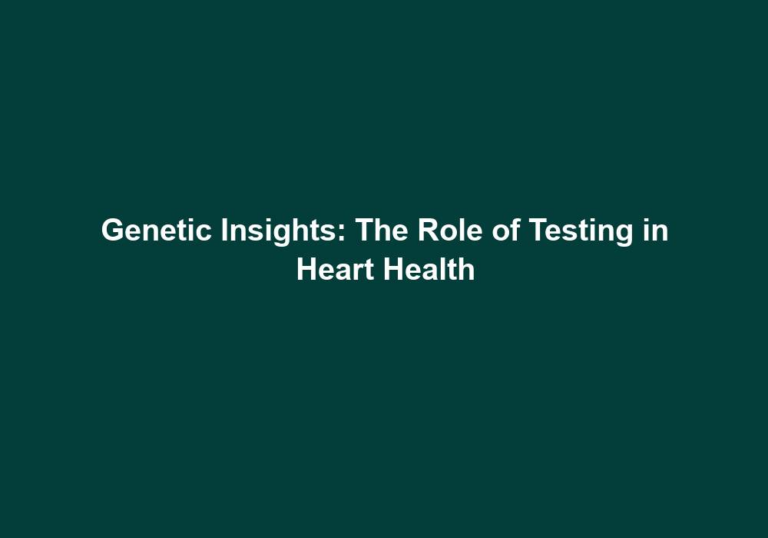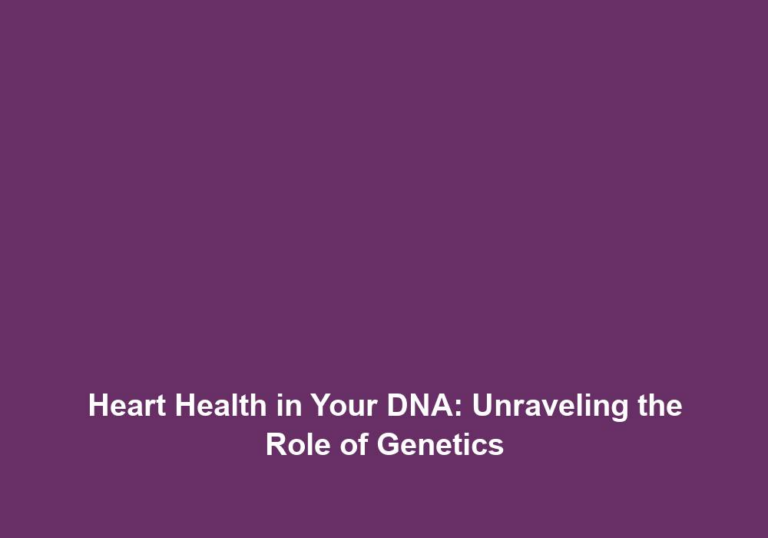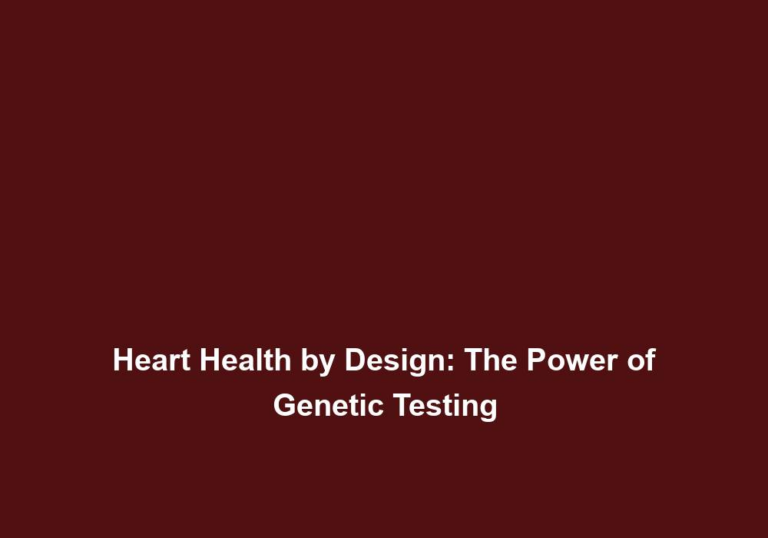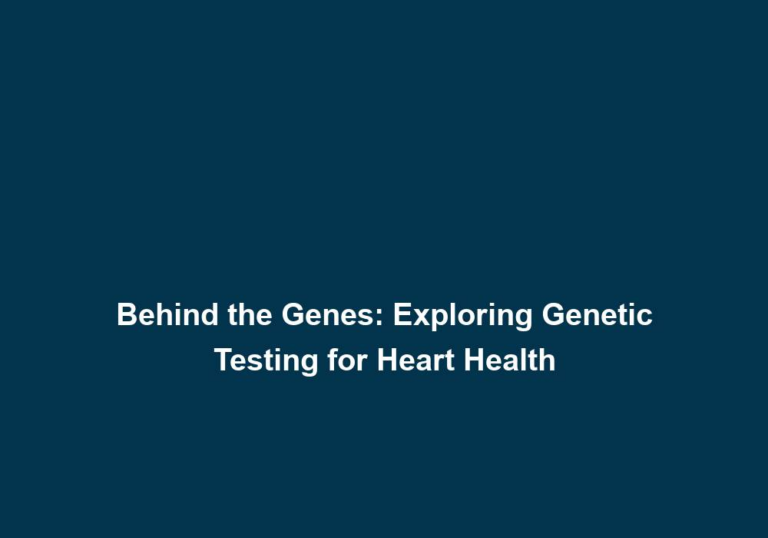Turning the Tide: Addressing Risk Factors for a Healthier Heart
Heart disease continues to be a leading cause of death worldwide. However, by understanding and addressing the risk factors associated with heart health, we can work towards turning the tide and promoting a healthier heart. In this article, we will delve into various risk factors and provide actionable strategies to mitigate them.
The Importance of Heart Health
The heart is a vital organ responsible for pumping oxygen-rich blood throughout our body. It is crucial to prioritize heart health to reduce the risk of heart disease, heart attacks, strokes, and other cardiovascular complications.
Maintaining heart health is essential not only for physical well-being but also for overall quality of life. A healthy heart ensures that our body receives a steady supply of oxygen and nutrients, enabling all organs and tissues to function optimally. On the other hand, poor heart health can lead to various complications, such as heart failure, arrhythmias, and even death.
To promote heart health, it is important to adopt a holistic approach that encompasses lifestyle modifications, regular exercise, and a heart-healthy diet. By incorporating these habits into our daily routine, we can significantly reduce the risk of developing heart disease and improve our overall well-being.
Risk Factors for Heart Disease
Several risk factors contribute to the development of heart disease. By identifying and addressing these factors, we can significantly reduce the chances of heart-related complications. Let’s explore some common risk factors:
1. High Blood Pressure
High blood pressure, or hypertension, is one of the leading risk factors for heart disease. When blood pressure remains consistently high, it puts strain on the heart and blood vessels, increasing the risk of heart attacks and strokes.
To address high blood pressure, it is essential to make lifestyle modifications that promote healthy blood pressure levels. This includes adopting a diet rich in fruits, vegetables, whole grains, and lean proteins, as well as limiting salt intake to less than 2,300 milligrams per day. Regular physical activity, such as brisk walking or cycling, can also help lower blood pressure. Additionally, avoiding smoking and excessive alcohol consumption and managing stress through techniques like meditation or yoga can further contribute to maintaining healthy blood pressure levels.
2. High Cholesterol Levels
High levels of cholesterol in the blood can lead to the formation of plaque in the arteries, restricting blood flow to the heart. This condition, known as atherosclerosis, significantly increases the risk of heart disease.
To manage cholesterol levels and reduce the risk of heart disease, it is important to adopt a healthy lifestyle and make dietary choices that promote heart health. This includes consuming a diet low in saturated and trans fats, which are known to raise cholesterol levels. Instead, incorporating heart-healthy fats like avocados, nuts, and olive oil can help maintain optimal cholesterol levels. Increasing dietary fiber intake through fruits, vegetables, and whole grains can also have a positive impact on cholesterol levels. Regular physical exercise is another effective strategy for managing cholesterol levels, as it can boost HDL (good) cholesterol levels. In some cases, medication may be necessary, so it is important to consult a healthcare professional about appropriate treatment options.
3. Diabetes
Diabetes is a chronic condition characterized by high blood sugar levels. Individuals with diabetes are at a higher risk of developing heart disease.
To manage diabetes and reduce the associated risk of heart disease, it is crucial to maintain stable blood sugar levels. This can be achieved by following a balanced diet consisting of whole foods and limited processed sugars. Monitoring blood sugar levels regularly and taking prescribed medications as directed are also important aspects of diabetes management. Engaging in regular physical activity can help control blood sugar levels and improve heart health. Additionally, maintaining a healthy weight through a combination of diet and exercise is essential for managing diabetes and reducing the risk of heart disease.
4. Obesity
Excess body weight, particularly around the waistline, increases the likelihood of developing heart disease. Obesity is often associated with other risk factors such as high blood pressure, high cholesterol, and diabetes.
To address obesity and promote heart health, it is important to adopt a multifaceted approach that includes lifestyle modifications and healthy habits. Adopting a balanced and calorie-controlled diet is crucial for weight management. Incorporating regular physical exercise into the daily routine, aiming for at least 150 minutes of moderate-intensity activity per week, can help burn calories, improve cardiovascular fitness, and promote weight loss. Seeking professional guidance, if needed, to develop a personalized weight loss plan can provide additional support and accountability. Staying motivated by setting achievable goals and tracking progress is also important for long-term success in managing obesity and improving heart health.
5. Lack of Physical Activity
Leading a sedentary lifestyle is detrimental to heart health. Regular physical activity is essential for maintaining a healthy weight, managing blood pressure, and improving overall cardiovascular fitness.
To increase physical activity levels and promote heart health, it is important to incorporate exercise into daily life. Engaging in aerobic exercises like walking, jogging, swimming, or cycling can help improve cardiovascular fitness and burn calories. Incorporating strength training exercises into the routine can help build muscle and boost metabolism. Finding activities that are enjoyable can make exercise more sustainable in the long run. Setting aside dedicated time for physical activity each day, even if it’s just a short walk, can ensure consistency and make it a habit.
6. Unhealthy Diet
Poor dietary choices significantly contribute to the development of heart disease. Diets high in saturated fats, trans fats, processed sugars, and sodium increase the risk of various cardiovascular complications.
To adopt a heart-healthy diet, it is important to make informed food choices that prioritize nutrient-dense options. This includes consuming a variety of fruits, vegetables, whole grains, lean proteins, and healthy fats. Limiting the consumption of processed foods, sugary beverages, and foods high in saturated and trans fats can help reduce the risk of heart disease. Reading food labels carefully and choosing low-sodium options whenever possible can also contribute to a heart-healthy diet. Controlling portion sizes is another important aspect of maintaining a healthy weight and preventing overeating.
Conclusion
Turning the tide on heart disease requires addressing and managing various risk factors. By adopting a healthy lifestyle, managing chronic conditions, and making informed dietary choices, we can significantly reduce the likelihood of heart-related complications. Prioritize your heart health today and take proactive steps towards a healthier future.







